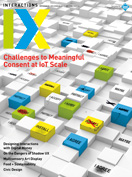Authors:
Samantha Shorey, Sarah Fox, Kristin Dew
Failure has become something of a fixture in technological industries. In Silicon Valley, mantras like "fail fast" motivate a cycle of start-ups and fizzle-outs, encouraging innovators to move through ideas until they get to the good one. Through "failing forward" they can fail productively, using each idea as a stepping stone toward eventual individual success. With these fail-centered notions, an artifact is successful if it improves and advances a design toward a singular output or product. Underlying many of these design philosophies is a teleological belief in the linear progression toward better and more powerful solutions [1]. Failure serves…
You must be a member of SIGCHI, a subscriber to ACM's Digital Library, or an interactions subscriber to read the full text of this article.
GET ACCESS
Join ACM SIGCHIIn addition to all of the professional benefits of being a SIGCHI member, members get full access to interactions online content and receive the print version of the magazine bimonthly.
Subscribe to the ACM Digital Library
Get access to all interactions content online and the entire archive of ACM publications dating back to 1954. (Please check with your institution to see if it already has a subscription.)
Subscribe to interactions
Get full access to interactions online content and receive the print version of the magazine bimonthly.






